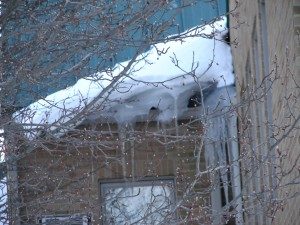Record snow falls throughout Northern lower peninsula and the Upper peninsula of Michigan is raging havoc on homeowners. Heavy snowfall in a time of persistent cold temperatures can ultimately result in an ice dam and a roof leak..
 The main problem is when snow melts from the roof when the temperature is below 32 degrees. The water runs down the roof freezing in the gutters and on the edge of the roof. This frozen mass of ice blocks water just as a dam does. This results in water making a pond behind the ice. No roof is designed to be flooded. The water flows under the shingles finding a nail hole or breach in the underlayment and leaks into the house.
The main problem is when snow melts from the roof when the temperature is below 32 degrees. The water runs down the roof freezing in the gutters and on the edge of the roof. This frozen mass of ice blocks water just as a dam does. This results in water making a pond behind the ice. No roof is designed to be flooded. The water flows under the shingles finding a nail hole or breach in the underlayment and leaks into the house.  What causes the snow to melt below 32 degrees?
What causes the snow to melt below 32 degrees? Ice dams are often caused by poor ventilation and the lack of dry insulation. Ventilation serves a dual role of exhausting built up heat in your roof and allowing moisture to escape. If you do not exhaust moisture from your roof, your insulation will absorb moisture. If you have 10 percent moisture you lose 25 percent of the insulating value. It is not uncommon for attics and roof systems to have moisture levels in the 20 percent range resulting in 50 percent heat loss and a doubling of your heating bills..
How to tell if you have a problem?1. Large icicles hanging from your roof 2. Snow melts unevenly on your roof 3. Moisture on your windows 4. Large fuel bills
What to Do?NEVER attempt to go up on an icy or snowy roof. Fill one leg of a pantyhose with ice melt (calcium chloride). Tie off both ends like a sausage about 18 inches long. Place on the roof perpendicular to the gutters on top of the ice. The ice melt will melt down through the ice allowing the water to run off the roof. Once you have taken care of the immediate danger contact a professional to evaluate your roof situation.
+John UrogdyTags
Subscribe to American Metal Roofs's Blog

Comments